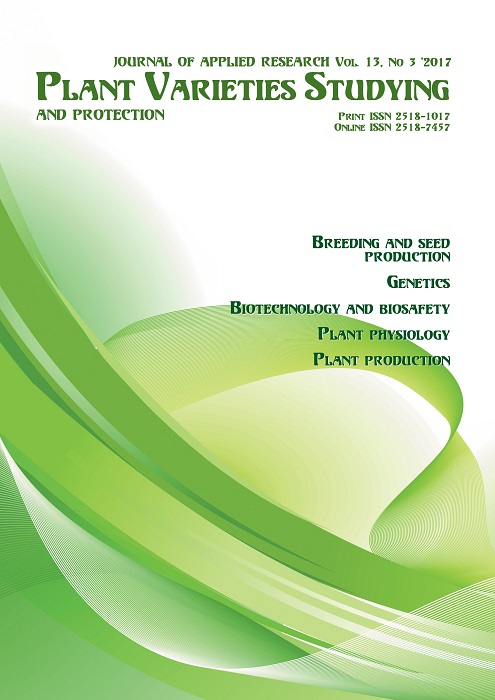Practical aspects of applying statistical analysis of quantitative characters of сutting lettuce varieties var. <em>сapitata</em> L.
DOI:
https://doi.org/10.21498/2518-1017.13.3.2017.110716Keywords:
cutting lettuce, variety, morphological characters, collection, selection, distinctness, descriptive statistics, cluster analysis, clustering, Ward’s methodAbstract
Purpose. To determine and substantiate practical aspects of statistical analysis application for management results of the morphological description of cutting lettuce (Lactuca sativa L.) varieties when identifying them during corresponding phenological phases of growth and development.
Methods. Field study, analytical approach based on descriptive statistics and cluster analysis.
Results. Quantitative values of display of such morphological characters as leaf rosette diameter, lettuce head size, leaf blade thickness and its venation were determined for the Lactuca sativa L. varieties. Statistical indices of four morphological characters of randomized sampling frame of seven cutting lettuce varieties were determined and the results of statistical analysis were interpreted. Cutting lettuce of loose leaf and capitate varieties was identified during corresponding phenological phases of growth and development. The most suitable method for clustering cutting lettuce varieties was defined. The results of clustering were interpreted. It was found that ‘Hodar’ variety differed greatly from others, ‘Dumka’ and ‘Olzhych’ varieties were the most similar.
Conclusions. The results of the identification allowed to establish that capitate lettuce varieties were similar in the following combinations: ‘Bona’ and ‘Dyvohray’, ‘Olzhych’ and ‘Dumka’. According to the duration of interphase periods, it can be noted that such varieties as ‘Dumka’ and ‘Dyvohrai’ had the highest rate of maturation in comparison with ‘Bona’ and ‘Hodar’ varieties, and the lowest one as compared to the ‘Olzhych’ variety
Downloads
References
Kondratenko, S. I., Tkalych, Yu. V., Korniienko, S. I., Horova, T. K., Mytenko, I. M., Bashtan, N. O., … Hart, O. Yu. (2015). Guidelines-klasyfikator provedennia ekspertyzy sortiv roslyn na vidminnist, odnoridnist i stabilnist (VOS) salatu posivnoho (Lactuca sativa L.) [Мethodology-classifier for the conduct of tests for distinctness, uniformity and stability (DUS) of cutting lettuce (Lactuca sativa L.)]. Kharkiv: N.p. [in Ukrainian]
Metodyka provedennia ekspertyzy sortiv roslyn hrupy ovochevykh, kartopli ta hrybiv na vidminnist, odnoridnist i stabilnist [Guidelines for the conduct of tests for distinctness, uniformity and stability of plant varieties of the group of vegetables, potato and mushrooms]. Retrieved from http://sops.gov.ua/pdfbooks/01.vidannia/Metodiki/vos/Ovochevi.pdf [in Ukrainian]
Goryainova, E. R., Pankov, A. R., & Platonov, E. N. (2012). Prikladnye metody analiza statisticheskikh dannykh [Applied methods of statistical analysis]. Moscow: Vysshaya shkola ekonomiki. [in Russian]
Ketskalo, V. V. (2007). The suitability of new varieties of loose-leaved lettuce for cultivating in the conditions of the Right-Bank Forest-Steppe zone. Zbirnyk naukovykh prats Umanskoho derzhavnoho ahrarnoho universytetu [Proceedings of Uman State Agrarian University], 65(2), 234–238. [in Ukrainian]
Leshchuk, N. V., Kryvytskyi, K. M., Maister, N. V., & Bronovytska, M. A. (2010). Integral evaluation of biological potential of (Lactuca sativa L.) varietal resources. Plant Varieties Studying and Protection, 2, 63–70. doi: 10.21498/2518-1017.2(12).2010.59308. [in Ukrainian]
Byuyul, A., & Tsefel, P. (2002). SPSS: iskusstvo obrabotki. Analiz statisticheskikh dannykh i vosstanovlenie skrytykh zakonomernostey [SPSS: Arts of processing. Analysis of statistical data and restoration of hidden patterns]. St. Petersburg: DiaSoftYuP. [in Russian]
Compton, M. E. (1994). Statistical methods suitable for the analysis of plant tissue culture data. Plant Cell Tiss Organ Cult, 37(3), 217–242. doi: 10.1007/BF00042336
Bryman, A., & Cramer, D. (2011). Quantitative Data Analysis with IBM SPSS 17, 18 and 19: A Guide for Social Scientists. New York: Routledge.
Levesque, R. (2007). SPSS Programming and Data Management: A Guide for SPSS and SAS Users. (4th ed.). Chicago, Illinois: SPSS Inc.
Downloads
Published
How to Cite
Issue
Section
License
Copyright (c) 2017 Ukrainian Institute for Plant Variety Examination

This work is licensed under a Creative Commons Attribution-ShareAlike 4.0 International License.
Starting in 2022, the copyright to the publication remains with the authors
Our journal abides by the CREATIVE COMMONS copyright rights and permissions for open access journals.
Authors, who are published in this journal, agree to the following conditions:
- The authors reserve the right to authorship of the work and pass the first publication right of this work to the journal under the terms of a Creative Commons Attribution License, which allows others to freely distribute the published research with the obligatory reference to the authors of the original work and the first publication of the work in this journal.
- The authors have the right to conclude separate supplement agreements that relate to non-exclusive work distribution in the form in which it has been published by the journal (for example, to upload the work to the online storage of the journal or publish it as part of a monograph), provided that the reference to the first publication of the work in this journal is included.

























 Ukrainian Institute for Plant Varieties Examination
Ukrainian Institute for Plant Varieties Examination  Селекційно-генетичний інститут
Селекційно-генетичний інститут Institute of Plant Physiology and Genetics of the National Academy of Sciences of Ukraine
Institute of Plant Physiology and Genetics of the National Academy of Sciences of Ukraine
 The National Academy of Agrarian Sciences of Ukraine
The National Academy of Agrarian Sciences of Ukraine